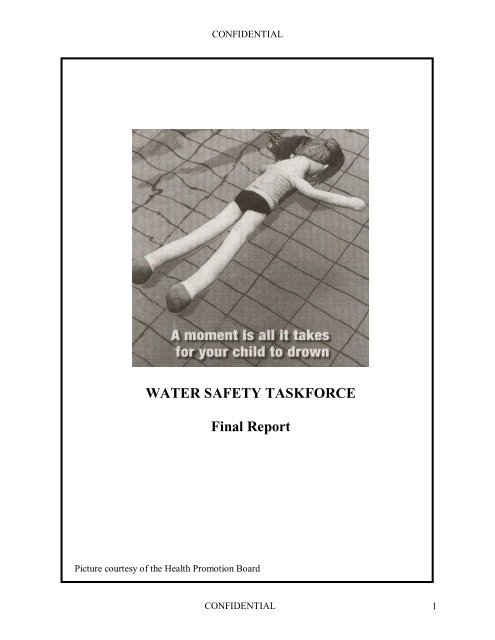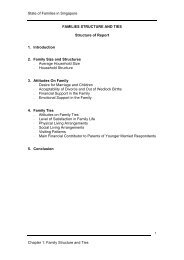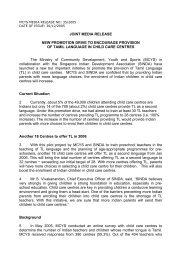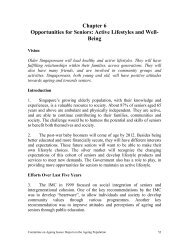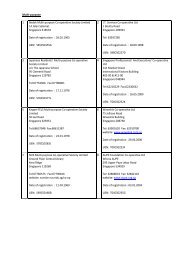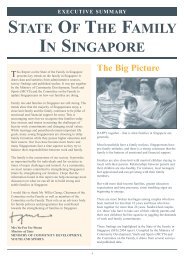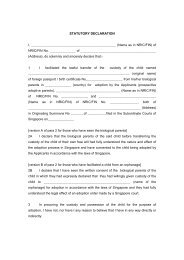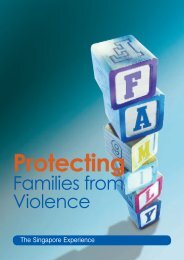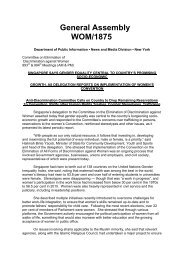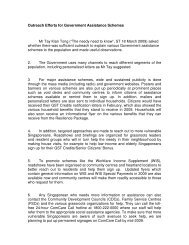WATER SAFETY TASKFORCE Final Report - Ministry of Social and ...
WATER SAFETY TASKFORCE Final Report - Ministry of Social and ...
WATER SAFETY TASKFORCE Final Report - Ministry of Social and ...
You also want an ePaper? Increase the reach of your titles
YUMPU automatically turns print PDFs into web optimized ePapers that Google loves.
CONFIDENTIAL<strong>WATER</strong> <strong>SAFETY</strong> <strong>TASKFORCE</strong><strong>Final</strong> <strong>Report</strong>Picture courtesy <strong>of</strong> the Health Promotion BoardCONFIDENTIAL 1
CONFIDENTIALCONTENTSBACKGROUND 3Terms <strong>of</strong> Reference <strong>and</strong> Composition <strong>of</strong> the Taskforce 3CONCEPTUAL FRAMEWORK 5Guiding Principles 5Key Objectives 5REVIEW OF EXISTING MEASURES 7RECOMMENDATIONS 8PROPOSED NATIONAL <strong>WATER</strong> <strong>SAFETY</strong> COUNCIL 10CONCLUSION 13ANNEX A – Statistics on Death by Drowning in Singapore 1940 - 2005 14ANNEX B – Average Drowning Deaths <strong>and</strong> Death Rates per 5-year blocks 16(Singapore 1960-2005)ANNEX C – Taskforce Members 17ANNEX D – Water Safety Matrix 19Categorised according to Key Objectives <strong>and</strong> Population Segments 19Categorised according to Location <strong>and</strong> Population Segments 20PA Sea Sports Club – Current Initiatives / Practices 22ANNEX E – Water Safety at PUB’s Water Bodies 23CONFIDENTIAL 2
CONFIDENTIALCONCEPTUAL FRAMEWORKGuiding Principles10 The Taskforce agreed to adopt the following guiding principles for its work:(a) The overall framework to promote Water Safety must be holistic <strong>and</strong> comprehensive – Itshould aim to cover all segments <strong>of</strong> the population <strong>and</strong> the different locations <strong>of</strong> waterbodies; <strong>and</strong>(b) Initiatives to promote Water Safety must be sustainable over a period <strong>of</strong> time.Key Objectives11 In June 2002, more than 500 experts from all over the world attended the World Congresson Drowning (Amsterdam) to develop insight into methods to reduce the number <strong>of</strong> drowningcases <strong>and</strong> incidents. This Congress was organised by the Dutch Society to Rescue People fromDrowning, a non-pr<strong>of</strong>it organisation founded in 1767. The Congress also surfaced many aspects<strong>of</strong> drowning prevention. The final draft <strong>of</strong> 13 recommendations covered areas from the definition<strong>of</strong> drowning to rescue techniques. Guided by the deliberations <strong>of</strong> the Congress, this Taskforcenarrowed its focus to three key objectives:Objective 1: Safety Awareness(a) The Taskforce observed that between 2001-2004, 10% <strong>of</strong> drowning in Singaporeoccurred in a swimming pool. This is an important indicator that there is a lack <strong>of</strong> WaterSafety awareness outside the pool since 90% <strong>of</strong> drowning happened in places like the sea,rivers, canals <strong>and</strong> the reservoirs. In addition, one <strong>of</strong> the recommendations <strong>of</strong> the WorldCongress on Drowning highlighted the importance <strong>of</strong> having aquatic safety education asthe basic fundamental tool in any drowning prevention strategy. The Taskforcerecognised this as the most critical pillar that will anchor our framework to promoteWater Safety.Objective 2: Swimming Pr<strong>of</strong>iciency(b) The World Congress on Drowning also acknowledged the importance <strong>of</strong> learning toswim in its recommendation because it would be a critical “life skill”. Although there islimited research to demonstrate a strong link 3 between the acquisition <strong>of</strong> swimmingskills <strong>and</strong> an individual’s ability to survive in water, the Taskforce concurs with theposition <strong>of</strong> the World Congress on Drowning, <strong>and</strong> we view swimming pr<strong>of</strong>iciency asequally important as safety awareness. Hence, we would strongly encourage that allSingaporeans, particularly our youth, learn to swim <strong>and</strong> build up their water confidence.3 Source: Brenner, R.A., Prevention <strong>of</strong> drowning in infants, children, <strong>and</strong> adolescents, American Academy <strong>of</strong>Pediatrics, Vol 112, No.2.CONFIDENTIAL 5
CONFIDENTIALObjective 3: Rescue <strong>and</strong> Environment / Equipment Design(c) Environmental design changes could reduce the incidence <strong>of</strong> drowning. A study by theUnited States Army Corps <strong>of</strong> Engineers found that environmental design changes 4 ataquatic facilities played a role in reducing recreation-related drowning by 73% (between1981 <strong>and</strong> 1995), even though visitation at the public facilities managed by them increasedby 66%. Supervision by lifeguards, as well as parents <strong>and</strong> other minders, was anotherpositive factor in the reduction <strong>of</strong> drowning or near-drowning incidents.12 The overall conceptual framework showing the key objectives as an overlay to thedifferent locations <strong>of</strong> water bodies in Singapore is shown in the diagram below. It presents itselfas a holistic framework on Water Safety that covers the promotion <strong>of</strong> the awareness <strong>of</strong> WaterSafety, the attainment <strong>of</strong> swimming pr<strong>of</strong>iciency, <strong>and</strong> the application <strong>of</strong> lifesaving skills <strong>and</strong>equipment.<strong>WATER</strong> <strong>SAFETY</strong> TASK FORCEOVERALL FRAMEWORKSSC Pools &Club PoolsHomeEnvironmentObjectivesSafety AwarenessSwimming Pr<strong>of</strong>iciencyRescue/ Envt & Equip DesignResidential PoolsPublic Waters*(Beaches /Reservoirs)* Includes local <strong>and</strong> overseas beaches <strong>and</strong> water-based bodies4 The changes included having buoys <strong>and</strong> markers to delimit swimming areas <strong>and</strong> lifesaving devices consisting <strong>of</strong>life jugs, ring buoys <strong>and</strong> lines, poles <strong>and</strong> prominent signs. Source: Keshlear, B., Drowning prevention: An ArmyCorps <strong>of</strong> Engineers perspective, in Fletemeyer, J.R. <strong>and</strong> Freas, S.M., (eds) Drowning: News Perspectives onIntervention <strong>and</strong> Prevention (1999) 165-75.CONFIDENTIAL 6
CONFIDENTIALStrengthen <strong>and</strong> Sustain Public Education EffortsRecommendation2. Organise annual campaigns <strong>and</strong> regular Community LifesavingProgrammes to promote Water Safety to members <strong>of</strong> the publicLead AgencySSC(b) The Taskforce recognised the need to address the root cause <strong>of</strong> the issue – Lack <strong>of</strong>Safety Awareness. To ensure effective delivery <strong>of</strong> programmes <strong>and</strong> public educationmessages, the following influencers should be tapped to reach out to the differenttarget groups:Key InfluencersCommunity leadersLifeguards <strong>and</strong> swimming instructorsOrganisers <strong>of</strong> water-based activities (e.g.wind-surfing/ kayaking)Principals <strong>and</strong> teachers (particularly thoseteaching PE <strong>and</strong> HE)Parents <strong>and</strong> CaregiversRegulatory authorities (e.g. Building <strong>and</strong>Construction Authority (BCA)) or industryassociationsRegulatory authorities or industryassociationsTour guidesTarget GroupMembers <strong>of</strong> the publicUsers <strong>of</strong> swimming facilitiesParticipants in water-based activitiesChildren (mainly those in Primaryschool)ChildrenArchitects / developers <strong>of</strong>swimming pools or other waterfeaturesManagement corporations <strong>of</strong>condominiumsTouristsRecommendation3. Set up a Water Safety Pool (similar to the “Road Safety Park”) toshowcase safe practices, operations <strong>and</strong> systems4. Launch <strong>and</strong> maintain an interactive Water Safety website whereusers could feedback suggestions, ideas or even participate ingames to enhance awareness <strong>of</strong> Water SafetyLead AgencySSCSSCOversee <strong>and</strong> Coordinate Longer-term Initiatives(c) In addition to the two key thrusts highlighted above, the Taskforce also identifiedother issues pertaining to the review <strong>of</strong> pool design regulations to enhance WaterSafety <strong>and</strong> further research to study local data on drowning incidences. In order todrive <strong>and</strong> sustain these longer-term initiatives, the Taskforce recognised the need fora national body/platform to coordinate Water Safety programmes <strong>and</strong> initiativesacross the various government <strong>and</strong> non-government agencies.CONFIDENTIAL 9
CONFIDENTIALRecommendation5. Set up a National Water Safety Council for Singapore as thenational coordinating body overseeing all aspects <strong>of</strong> Water Safety;this should be integrated with the focus on sports safety in thepromotion <strong>of</strong> sports participation in the community. The proposedCouncil should have a dedicated programme budget to fund interagencyinitiatives related to promoting Water Safety6. Review regulations on pool design to remove unsafe designfeatures7. Embark on further research to study the local data on drowningincidencesLead AgencyMCYS/SSCNational WaterSafety CouncilNational WaterSafety CouncilPROPOSED NATIONAL <strong>WATER</strong> <strong>SAFETY</strong> COUNCILCase Study: Australian Water Safety Council• The Australian Water Safety Council (AWSC) was formed in year 1998 to combatdrownings in Australia following the increase in deaths at beaches during the summer <strong>of</strong>1997. The AWSC developed <strong>and</strong> released a National Water Safety Plan 7 (1998-2003)which was then the first national strategic document focusing on Water Safety.• In year 2004, the AWSC built on the foundations <strong>of</strong> the earlier Plan <strong>and</strong> released theNational Water Safety Plan (2004-07). The aims <strong>of</strong> the Plan were to:(a) Identify <strong>and</strong> prioritise the major Water Safety issues(b) Establish the national Water Safety st<strong>and</strong>ards(c) Commit to support, bolster <strong>and</strong> improve the expertise, programmes <strong>and</strong> resourcesthat are already operating effectively within their existing systems(d) Identify <strong>and</strong> maximise organisational linkages to ensure that duplication <strong>of</strong> effort<strong>and</strong> resources are avoided so that positive ideas <strong>and</strong> best practices are sharednationally• Since its formation, the AWSC had played a key leadership role in spearheadingcollaboration between all levels <strong>of</strong> government, Water Safety organisations as well assport <strong>and</strong> recreation service providers. Currently, it comprises 13 members from variousorganisations <strong>and</strong> related government agencies interested in Water Safety in Australia.7 At the time <strong>of</strong> publication <strong>of</strong> the Water Safety Plan (1998-2003), more than 300 Australians drowned each year.By the end <strong>of</strong> the period, the country had seen a reduction <strong>of</strong> 17% to 250 drowning deaths each year. Currently,drowning ranks as the fourth largest cause <strong>of</strong> unintentional deaths in Australia.CONFIDENTIAL 10
CONFIDENTIAL16 The Taskforce observed that Australia would have found it much more difficult toachieve the objectives as set out in their National Water Safety Plan if they did not have acollaborative <strong>and</strong> consultative platform such as the AWSC. The Taskforce was <strong>of</strong> the view that asimilar setup would also work for Singapore in overseeing all efforts to promote Water Safety.17 A National Water Safety Council could be set up as a st<strong>and</strong>ing committee with membersappointed on a two-year term with the following terms <strong>of</strong> reference:Terms <strong>of</strong> ReferenceTo build on the work <strong>of</strong> the Water Safety Taskforce by:(a) Initiating <strong>and</strong> coordinating public education efforts as well as efforts to increasechildren’s participation in swimming programmes through the various platforms(b) Reviewing pool design regulations to enhance Water Safety(c) Embarking on further research to study local data on drowning incidences(d) Overseeing water safety <strong>and</strong> establishing national water safety st<strong>and</strong>ards in areassuch as: 8(i) Guidelines for safe pool operations(ii) Home pool inspection system(iii) National signage st<strong>and</strong>ardsCompositionThe proposed National Water Safety Council for Singapore could comprise representativesfrom the following organisations:• <strong>Ministry</strong> <strong>of</strong> Community Development, Youth <strong>and</strong> Sports, Singapore Sports Council[Swimming programmes in schools]• Health Promotion Board, Singapore Life Saving Society, Singapore Tourism Board[Public education]• <strong>Ministry</strong> <strong>of</strong> Education [Water Safety lessons in schools]• Public Utilities Board, People’s Association, National Parks Board, Singapore SportsCouncil [Enforcement <strong>of</strong> Water Safety near water bodies]• Building <strong>and</strong> Construction Authority, NUS Department <strong>of</strong> Architecture, SingaporeInstitute <strong>of</strong> Architects, National Environment Agency [Review <strong>of</strong> pool designregulations]8 This is with reference to AWSC’s national water safety st<strong>and</strong>ards.CONFIDENTIAL 11
CONFIDENTIALComposition• <strong>Ministry</strong> <strong>of</strong> Health, <strong>Ministry</strong> <strong>of</strong> Home Affairs, Singapore Life Saving Society[Research <strong>and</strong> data analysis]• Other private sector representativesCONFIDENTIAL 12
CONFIDENTIALCONCLUSION18 Currently, various agencies already have in place different initiatives <strong>and</strong> programmes toaddress Water Safety <strong>and</strong> drowning prevention. The Water Safety Taskforce provided a timelyplatform for a stock-take <strong>of</strong> these efforts <strong>and</strong> to propose recommendations to enhance theexisting measures.19 There would be a need to ensure that the recommendations can be followed through by anational coordinating body with authority over the issue <strong>of</strong> Water Safety. Australia, with the help<strong>of</strong> its Water Safety Council, was able to reduce the number <strong>of</strong> drowning deaths by 17% withinthe first five years. For Singapore, we would be able to achieve similar results if we could buildon the work <strong>of</strong> the Water Safety Taskforce <strong>and</strong> sustain our efforts in all aspects <strong>of</strong> Water Safety.CONFIDENTIAL 13
CONFIDENTIALANNEX A – Statistics on Deaths by Drowning 9 in Singapore (1960 – 2005)YearCause <strong>of</strong> Death - Cause <strong>of</strong> Death -Accidental drowning Submersion& Submersion (Drowning)(ICDE910) 10 (ICDE984)TotalPopulation 11(TP)TP per100,000DrowningRate per100,0001960 65 - 1,646,400 16.46 3.951961 78 - 1,702,400 17.02 4.581962 91 - 1,750,200 17.50 5.201963 79 - 1,795,000 17.95 4.401964 99 - 1,841,600 18.42 5.381965 86 - 1,886,900 18.87 4.561966 104 - 1,934,400 19.34 5.381967 103 - 1,977,600 19.78 5.211968 89 - 2,012,000 20.12 4.421969 66 19 2,042,500 20.43 4.161970 75 17 2,074,500 20.75 4.431971 74 35 2,112,900 21.13 5.161972 51 43 2,152,400 21.52 4.371973 57 27 2,193,000 21.93 3.831974 70 33 2,229,800 22.30 4.621975 50 49 2,262,600 22.63 4.381976 45 40 2,293,300 22.93 3.711977 60 42 2,325,300 23.25 4.391978 30 54 2,353,600 23.54 3.571979 33 35 2,383,500 23.84 2.851980 37 49 2,413,900 24.14 3.561981 34 56 2,532,800 25.33 3.551982 33 44 2,646,500 26.47 2.911983 37 40 2,681,100 26.81 2.871984 36 59 2,732,200 27.32 3.481985 40 47 2,736,000 27.36 3.181986 37 37 2,733,400 27.33 2.711987 49 38 2,774,800 27.75 3.141988 23 36 2,846,100 28.46 2.071989 31 38 2,930,900 29.31 2.351990 32 35 3,046,100 30.46 2.201991 20 36 3,135,800 31.36 1.791992 18 32 3,232,100 32.32 1.551993 14 32 3,315,400 33.15 1.391994 18 27 3,421,100 34.21 1.329 Source: Annual RBD <strong>Report</strong>s, ICA, Singapore10 Causes <strong>of</strong> death follow the Mortality Tabulation List <strong>of</strong> the Ninth (1975) Revision <strong>of</strong> the InternationalClassification <strong>of</strong> Diseases (ICD). Category E910 represents all cases <strong>of</strong> accidental drowning & submersion, whereascategory E984 represents unspecified drowning & submersion. Note: Categories <strong>of</strong> Intentional drowning i.e. suicidehave been omitted, thus not included in the above table.11 Source: Population (Mid-Year Estimates) from the Department <strong>of</strong> Statistics, Singapore (Total Population is statedto comprise all citizens <strong>and</strong> permanent residents with local residence <strong>and</strong> foreigners staying in Singapore for oneyear or more)CONFIDENTIAL 14
CONFIDENTIALYearCause <strong>of</strong> Death -Accidental drowning& Submersion(ICDE910)Cause <strong>of</strong> Death -Submersion(Drowning)(ICDE984)TotalPopulation(TP)TP per100,000DrowningRate per100,0001995 12 19 3,525,600 35.26 0.881996 29 34 3,670,400 36.70 1.721997 28 37 3,793,700 37.94 1.711998 18 34 3,922,000 39.22 1.331999 16 27 3,950,900 39.51 1.092000 21 39 4,017,700 40.18 1.492001 25 16 4,131,200 41.31 0.992002 11 28 4,171,300 41.71 0.932003 15 21 4,185,200 41.85 0.862004 17 28 4,240,300 42.40 1.062005 27 11 4,351,400 43.51 0.87CONFIDENTIAL 15
CONFIDENTIALANNEX B – Average Unintentional Drowning Deaths <strong>and</strong> Death Rates per 5-year blocks(Singapore 1960-2005)5.004.504.70 4.754.481204.003.503.008293963.7888853.272.6975100802.50602.001.501.65531.345143401.001.04200.500.001960-1964 1965-1969 1970-1974 1975-1979 1980-1984 1985-1989 1990-1994 1995-1999 2000-20050Average number <strong>of</strong> deaths/100,000 population per 5-yearAverage number <strong>of</strong> deaths per 5-yearCONFIDENTIAL 16
CONFIDENTIALANNEX C – Taskforce MembersName Designation OrganisationAdvisorDr Teo Ho Pin Mayor NorthwestCDCTaskforce ChairmanMr David Tan(until Feb 06)Director, SportsMCYSMr Chan Mun Wei(w.e.f Feb 06)MembersMs Kok Lee KwangMs Genevieve Chye(until Feb 06)Deputy Director, Curriculum Planning &Development Division (Humanities &Aesthetics)Assistant Director, Curriculum Planning &Development Division (Humanities &Aesthetics)MOEMOEMs Daphne Poon(w.e.f Mar 06)Ms Lim Wen Chye Joey Curriculum Planning Officer,MOEPhysical EducationMs Delphine Fong Deputy Director (Sports Safety) SSCMr Koh Boon Aik Deputy Director (Best Sourcing)/ PUBHead (Health, Safety, Security <strong>and</strong>Emergency Preparedness)Mr Lau Yew Hoong(until July 06)Deputy Director (Health, Safety, Security<strong>and</strong> Emergency Preparedness)PUBMr Fong Ping Chiong(w.e.f July 06)Dr Wong Mun Loke(until July 06)Ms V Prema(w.e.f Aug 06)Mr Tan Mong KiangMr Richard Tan MingKirkMr Alfred Chua(until Jun 06)Senior Manager, (Best Sourcing)/(Health,Safety, Security <strong>and</strong> EmergencyPreparedness)Head (School Health PromotionDepartment)Deputy Director Disease PreventionEducation Dept, Youth Health DivisionAssistant Director (Recreation)North East Community DevelopmentDivisionHonorary Secretary-GeneralManagerHPBPASLSS*SLSS*CONFIDENTIAL 17
CONFIDENTIALMr Oon Jin Gee Vice-President, Swimming SingaporeSwimmingAssociationSecretariatMr Lim Keum Keow(until Aug 06)Manager, SportsMCYSMr Edwin Seah(until Dec 06)Mr Melvin Yeo(w.e.f. Jan 07)Ms Jamie HuangAssistant Director, SportsAssistant Director, SportsProject Officer* The Singapore Life Saving Society (SLSS) is a non-pr<strong>of</strong>it organisation with a mission topromote aquatic safety <strong>and</strong> lifesaving. The SLSS is a charity registered under the Charities Act1982 (Reg. No. 0002) <strong>and</strong> an Institution <strong>of</strong> Public Character. The SLSS is also a member <strong>of</strong> theNational Council <strong>of</strong> <strong>Social</strong> Service, a national sports association recognised by the SingaporeSports Council, a national member <strong>of</strong> The Royal Life Saving Society, Commonwealth, <strong>and</strong> anational member <strong>of</strong> The International Life Saving Federation.CONFIDENTIAL 18
CONFIDENTIALANNEX D – Water Safety MatrixCategorised according to Key Objectives <strong>and</strong> Population Segments(I)OBJECTIVESChildren < 12(A) Safety Awareness(II)Teens 12 – 16Proposed review <strong>of</strong> PE Syllabus (Primary / Secondary / Post-Secondary)• MOE will review the safety awareness content in the PE syllabus in 2008.• Inputs to be obtained from SSC, PA & PUB on water safety in different contexts(III)Youths 17 – 25(IV)Working Adults(V)Elderly > 60Proposed Water Safety Campaign• To mount a national Water Safety campaign to raise public awareness <strong>of</strong> the various facets <strong>of</strong> Water Safety. This campaign should be a multi-sectoral effort involving various organisations.• SSC <strong>and</strong> SLSS could help train <strong>and</strong> identify the best <strong>and</strong> passionate speakers to promote Water Safety awareness.Other public education initiatives foryoung children• To distribute resources (e.g. activitybooklets) to educate children on WaterSafety as part <strong>of</strong> the “Safety@Play”messages.• To conduct activities (e.g.competitions) aimed at helpingchildren learn more about WaterSafety.• To organise community roadshows toeducate children <strong>and</strong> parents on WaterSafety.Other public education initiatives forteens• To consider education initiativesthrough small group sharing (e.g. aclass at a time <strong>and</strong> not via assemblysession).• To consider using celebrities as rolemodels as they would appear “cool”<strong>and</strong> are attractive to teens.Other public education initiatives forworking adults• To conduct training seminars toeducate parents <strong>and</strong> caregivers <strong>of</strong>children on Water Safety. Theproposed Water Safety campaignshould also raise awareness amongstadults.• To organise community roadshows toeducate children <strong>and</strong> parents on WaterSafety.Other public education initiatives forsenior citizens• Many senior citizens take up morningswimming at the swimming pools <strong>and</strong>beaches. They should be educated toavoid:- swimming alone;- swimming without informingtheir family members;- swimming too far from theshoreline, as normally seen atthe East Coast beach.(B)SwimmingPr<strong>of</strong>iciencyCurrent programmes / schemes to promote swimming pr<strong>of</strong>iciency• SSC Learn-to-Swim programme• National Survival Swimming Award (NASSA) SchemeProposed review for Swimming Programmes <strong>of</strong>fered to schools (Primary / Secondary / Post-Secondary schools)• SSC <strong>and</strong> SLSS to review the safety pr<strong>of</strong>iciency content in their swimming programmes <strong>and</strong> to develop common st<strong>and</strong>ards onswimming pr<strong>of</strong>iciency to provide feedback to the coaches/instructors <strong>and</strong> learners• SLSS <strong>and</strong> SSC could also help to train <strong>and</strong> update instructors to better the conducting <strong>of</strong> drowning prevention activities.• SLSS <strong>and</strong> SSC to communicate with MOE PE unit <strong>and</strong> CCAB (Sports) on the desired outcomes when schools take on theswimming programmes as part <strong>of</strong> curriculum or CCA.Proposed enhancements to programmes• People’s Association (PA) to helpdrive programmes through thecommunity clubs, using SSC pools forclasses.(C) RescueCurrent arrangements for rescue (SSC pools)• Deployment <strong>of</strong> trained lifeguards equipped with safety <strong>and</strong> rescue equipment like AED, Oxy-Viva, First Aid boxes, floats <strong>and</strong> spinal boards.• Emergency Rescue plan in place at every poolProposed review on the Rescue Segment in Swimming Programmes <strong>of</strong>fered to schools (Primary / Secondary / Post-Secondary)• SSC <strong>and</strong> SLSS to work with instructors <strong>and</strong> coaches for the rescue segment to outline the desired outcomes in theirprogrammes• SSC to communicate with MOE PE unit & CCAB(Sports) on the desired outcomes when schools take on swimmingprogrammes as part <strong>of</strong> curriculum or CCA.CONFIDENTIAL 19
CONFIDENTIALOBJECTIVES(I)Children < 12(II)Teens 12 – 16(III)Youths 17 – 25(IV)Working Adults(V)Elderly > 60(D) OthersProposed Water Safety Council for Singapore• To establish a Water Safety Council as the national coordinating body with full ownership <strong>and</strong> authority over the issue <strong>of</strong> Water Safety. It could also act as a consultative forum involving government agencies <strong>and</strong>non-governmental organisations committed to the promotion <strong>and</strong> enhancement <strong>of</strong> Water Safety in Singapore.Categorised according to Location <strong>and</strong> Population Segments(I)LOCATIONSChildren < 12(1) SSC PoolsCurrent arrangements on Water Safety• Signs <strong>and</strong> Notices to Warn <strong>and</strong> Educate Users(II)Teens 12 – 16- Listing <strong>of</strong> Do’s <strong>and</strong> Don’ts- Pool depth indicator- Water safety posters(III)Youths 17 – 25(IV)Working Adults(V)Elderly > 60• Patrons’ Surveillance <strong>and</strong> Other Measures- Weaker swimmers are advised to use the shallow pool area- SSC can temporarily close admission in event <strong>of</strong> over crowding• Future Plans - Revised certification <strong>and</strong> training for lifeguards- Review <strong>of</strong> work processes <strong>and</strong> enhancement <strong>of</strong> rescue equipment- Use <strong>of</strong> more pictograms <strong>and</strong> contrasting colours for safety signs <strong>and</strong> depth markers- Distribution <strong>of</strong> HPB’s educational materials through SSCStrict rules <strong>and</strong> regulations• Children (under 5 years old) must beaccompanied by adults <strong>and</strong> arerestricted to wading pool(2) Club PoolsProposed review <strong>of</strong> site design• To improve safety design features <strong>of</strong> pools (with BCA’s assistance)Proposed public education initiatives• SSC to distribute HPB’s educational materials through the club operators• SSC to encourage conducting <strong>of</strong> periodical lifesaving demonstration <strong>and</strong>/or Water Safety talks.(3) Private CondominiumPoolsProposed review <strong>of</strong> site design• To improve safety design features <strong>of</strong> pools (with BCA’s assistance)Proposed public education initiatives• SSC to distribute HPB’s educational materials through the Management Committees <strong>and</strong> to educate security guards about pool safety <strong>and</strong> life saving (e.g. CPR) skills.• SSC to encourage conducting <strong>of</strong> periodical lifesaving demonstration <strong>and</strong>/or Water Safety talks.(4) ReservoirsWater Safety-related guidelines enforced by the PUB• Only organised activities are allowed in the reservoirs.- Conditions including safety requirements are imposed on agencies responsible for organising the activities in the reservoirs.- All water sports / recreational activities participants must put on personal floating device while in the water.- No person is allowed to operate any boat in the reservoir without prior approval.• Signboards are erected in some reservoirs to warn the public <strong>of</strong> the presence <strong>of</strong> crocodiles.• No swimming (including bathing <strong>and</strong> washing) is allowed in the reservoir. Warning signs relating to safety are erected to warn the public.• Fishing is allowed only at designated areas. Life buoys are provided at the designated fishing grounds/jetties.CONFIDENTIAL 20
CONFIDENTIALLOCATIONS(I)Children < 12(II)Teens 12 – 16(III)Youths 17 – 25(IV)Working Adults(V)Elderly > 60(5) BeachesWater Safety-related rules <strong>and</strong> regulations enforced by the People’s Association Sea Sports Club (PA SSC)• Teens/Youths below the age <strong>of</strong> 18 must be under adult supervision (parent/guardian). Infant in arms are restricted from participating• Signs <strong>and</strong> notices to warn <strong>and</strong> educate users - Listing <strong>of</strong> Do’s <strong>and</strong> Don’ts- Listing <strong>of</strong> general rules <strong>and</strong> regulations <strong>and</strong> safety requirements at the operating outlet• Patrons’ surveillance <strong>and</strong> other measures - A safety boat is on st<strong>and</strong>by if in need.- In time <strong>of</strong> bad weather, an air horn will be sounded to recall all kayakers.- For users who are not certified, they must stay within the specified demarcated area (line <strong>of</strong> sight from the operating unit).- Certified users aged 13 years <strong>and</strong> above have a larger demarcated area (with areas <strong>of</strong> the reservoir out <strong>of</strong> bounds).Water Safety-related operational considerations by the People’s Association Sea Sports Club (PA SSC)• Give way to beach goers <strong>and</strong> swimmers when embarking or disembarking from crafts• Stay clear <strong>of</strong> breakwaters <strong>and</strong> retaining walls• Motorised crafts are to give way to non motorised crafts• Stay clear from fishing lines <strong>and</strong> nets• Stay close to shore/bank when new to the sport or surrounding• Stay within demarcated areasProposed review <strong>of</strong> safety coverage• To consider deploying lifeguards during peak-hours or festivals, where there are many beach users(6) Waterways (Rivers,Canals <strong>and</strong> drains)(7) Home EnvironmentWater Safety-related guidelines enforced by the PUB• No swimming is allowed in the waterways.• Safety railings are provided along the opened drains <strong>and</strong> canals. Warning signs are also put up in some locations to warn the public <strong>of</strong> the deep water in drains or canals.• At Singapore River, where parts <strong>of</strong> the banks are leased to adjacent l<strong>and</strong> owners, the leasers are responsible for safety in their use <strong>of</strong> the l<strong>and</strong>. They can opt not to use safety railings but must demarcate the edge <strong>of</strong>the river with chains, etc. The leasers have to re-erect the safety railings upon the termination <strong>of</strong> the lease.• At Sungei Tampines, there is an inflatable weir which holds back the water in the canal to form a water body for aesthetics reasons. The operation <strong>of</strong> the weir is such that when there is a storm, the weir woulddeflate <strong>and</strong> cause a sudden release <strong>of</strong> water downstream. For this situation, in addition to railings along the canal, there are also warning signs <strong>and</strong> sirens before operation <strong>of</strong> the weir deflation to warn <strong>of</strong> the suddengush into the mangrove swamp downstream. No water activity is to be allowed in this canal.• For wider rivers near to the sea, the banks could be s<strong>and</strong> beaches or rock bunds. For such situations, railings may not be appropriate <strong>and</strong> warning signs are erected instead to alert the public to the danger <strong>of</strong> strongcurrents <strong>and</strong> deep waters.• For reservoir tidal gates, a public address system with siren were erected to warn the public to keep clear from the channel before the tidal gates are opened.Water Safety-related guidelines as advised by the HPB• Do not leave child alone in the bathroom, especially the bathtub, even for a moment.• Keep pails <strong>and</strong> basins in bathroom covered or turned over when not in use.Proposed public education initiatives• SSC to distribute HPB’s educational materials to households (HDB/ Private homes)• SSC to encourage conducting <strong>of</strong> periodical lifesaving demonstration <strong>and</strong>/ or Water Safety talks. (through Community Centres for e.g.)(8) Overseas beaches &water-based bodiesNo specific arrangements/ regulations enforced at the momentCONFIDENTIAL 21
CONFIDENTIALPA Sea Sports Club – Current Initiatives / Practices(Kayaking, Windsurfing, Dragonboating, Sailing <strong>and</strong> Powerboating)(I)OBJECTIVES LOCATIONChildren < 12Sea Sports Clubs Not applicable*(A) SafetyPAddlez inc @Bedok ReservoirWater Safety-related rules <strong>and</strong>regulations apply (refer to the boxshown on the right)(II)Teens 12 – 16(III)Youths 17 – 25(IV)Working AdultsWater Safety-related rules <strong>and</strong> regulations enforced by the People’s Association Sea Sports Club (PA SSC)• All users must use a personal floating device (PFD)• All users are to check their equipment before drawing out• Footwear is m<strong>and</strong>atory• Demarcated areas are mapped out clearly in each club• All users must state their destination <strong>and</strong> time <strong>of</strong> return• Trainers in charge <strong>of</strong> respective course or activity adhere to the student to instructor ratio• All instructors <strong>and</strong> staff are First Aid/CPR trained• All clubs have an Emergency Action Plan (with the nearest hospital mapped out)• First Aid kits <strong>and</strong> stretchers are available in the club houses• In the event <strong>of</strong> bad weather <strong>and</strong> poor visibility, all users will be asked to return to the club house if possible or head to the nearest shore to wait(V)Elderly > 60(B) SwimmingPr<strong>of</strong>iciencySea Sports Clubs*PAddlez inc @Bedok ReservoirNot applicableWater Safety-related rules <strong>and</strong> regulations enforced by the People’s Association Sea Sports Club (PA SSC)• All course participants will be put through a 50metre swim test (water confidence). This is performed with the aid <strong>of</strong> the PFD at all beginner level courses, under thesupervision <strong>of</strong> an instructorWater Safety-related rules <strong>and</strong> regulations enforced by the People’s Association Sea Sports Club (PA SSC)• Swimming is prohibited in the reservoirs(C) RescueSea Sports Clubs*PAddlez inc @Bedok ReservoirNot applicableWater Safety-related rules <strong>and</strong>regulations apply (refer to the boxshown on the right)Water Safety-related rules <strong>and</strong> regulations enforced by the People’s Association Sea Sports Club (PA SSC)• All rescue personnel use a PFD• Safety boats are on st<strong>and</strong>by during operational hours• Rescues are performed by duty personal or trainers• Rescue equipment include tow lines, throw lines <strong>and</strong> rescue buoys• Emergency Rescue plan in place (with the nearest clinic/hospital mapped out) at all the clubs* Located at Changi, East Coast, Kallang <strong>and</strong> Pasir RisCONFIDENTIAL 22
CONFIDENTIALANNEX E – Water Safety at PUB’s Water BodiesWater safety at reservoirs1. PUB has opened up its reservoirs for more recreational activities for the public, such ascanoeing, kayaking, spot fishing etc. By so doing, PUB aims to get Singaporeans to have a newrelationship with water – appreciate water, value water <strong>and</strong> at the same time, enjoy water.2. Only organised activities are allowed in the reservoirs. PUB will refer to relevantauthorities or adopt relevant codes in advising the public when activities are being held in ourreservoirs.3. Notwithst<strong>and</strong>ing this, PUB has put in place the following measures to ensure the safety <strong>of</strong>the public:(a) All water sports / recreational activities participants must put on personal floating devicewhile in the water.(b) Conditions including safety requirements are imposed on agencies responsible fororganising the activities in the reservoirs.(c) Life buoys are provided at the designated fishing grounds/jetties.(d) In some reservoirs, signboards are erected to warn the public <strong>of</strong> the presence <strong>of</strong>crocodiles4. Please note that the following are also not allowed in reservoirs:(a) No swimming is allowed in the reservoir. Warning signboards relating to safety areerected to warn the public (photo 1 to 3).(b) Fishing is allowed only at designated areas (photo 4).(c) No person is allowed to operate any boat in the reservoir without prior approval.(d) No bathing <strong>and</strong> washing are allowed in the reservoir.Photo 1: Warning signboard at reservoirPhoto 2 : Warning signboard at reservoirCONFIDENTIAL 23
CONFIDENTIALPhoto 3 : NParks signboard at reservoir parkPhoto 4 : Fishing ground signWater safety at waterway (rivers, canals, drains)5. Water flow speed <strong>and</strong> water level in the canals <strong>and</strong> drains can increase rapidly within avery short time during a heavy downpour. PUB’s Code <strong>of</strong> Practice requires safety railings to beinstalled for opened drains <strong>and</strong> canals with depth more than 1 metre.6. PUB has put in place the following measures for waterways which are not covered:(a) No swimming is allowed in the waterways.(b) Safety railings are provided along the opened drains <strong>and</strong> canals. Warning signs are alsoput up in some locations to warn the public <strong>of</strong> the deep water in the drain or canals (photo5 to 6).(c) At Singapore River, where parts <strong>of</strong> the banks are leased to adjacent l<strong>and</strong> owners, theleasers are responsible for safety in their use <strong>of</strong> the l<strong>and</strong>. They can opt not to use safetyrailings but must demarcate the edge <strong>of</strong> the river with chains, etc. The leasers have to reerectthe safety railings upon the termination <strong>of</strong> the lease.(d) At Sungei Tampines, there is an inflatable weir which holds back the water in the canal t<strong>of</strong>orm a water body for aesthetics reasons. The operation <strong>of</strong> the weir is such that whenthere is a storm, the weir would deflate <strong>and</strong> cause a sudden release <strong>of</strong> water downstream.For this situation, in addition to railings along the canal, there are also warning signs <strong>and</strong>sirens before operation <strong>of</strong> the weir deflation to warn <strong>of</strong> the sudden gush into themangrove swamp downstream. No water activity is to be allowed in this canal.(e) For wider rivers near to the sea, the banks could be s<strong>and</strong> beaches or rock bunds. For suchsituations, railings may not be appropriate <strong>and</strong> warning signs are erected instead to alertthe public to the danger <strong>of</strong> strong currents <strong>and</strong> deep waters.(f) For reservoir tidal gates, a public address system with siren were erected (photo 7) towarn the public to keep clear from the channel before the tidal gates are opened.CONFIDENTIAL 24
CONFIDENTIALPhoto 5: Warning sign along a canalPhoto 6:Multi-lingual signboard along canalPhoto 7: Beacons <strong>and</strong> warning signsCONFIDENTIAL 25


